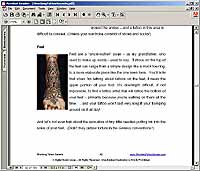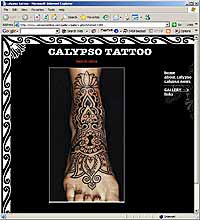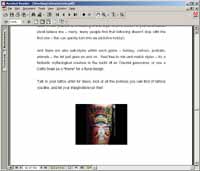
This article is about not sitting back and letting people take advantage of body modification artists and enthusiasts. It shows that we can fight back and win.
My favorite clichés of Barnard’s are about the reasons why people get tattoos: to please a lover, to be in a gang, and to be a “freespirit.” Oh, but freespirits be warned, “what happens when you grow up a little bit and want to go to work in that law firm and they won’t hire you because of that free spirit tattoo.” Perhaps it’s because Barnard never imagined the existence of tattooed lawyers that he flagrantly violated copyright laws by stealing images of tattoos to illustrate his text. Perhaps it’s because he didn’t think that anyone in the modified community is smart enough to understand basic principles of law, that is, because we’re all out getting our gang symbols etched into our skin. Perhaps it’s because he didn’t realize that one of the tattoo photos he stole might belong to a tattooist whose partner is a lawyer who wrote, “The Tattoo Copyright Controversy” discussing ways tattooists can protect themselves from the very violations Barnard committed. As one friend put, “This idiot fucked with the wrong freaks!” Yes, he did. And Barnard finally realized it when he received my email threatening suit. When I wrote the article for BME on copyrighting tattoos, I got a lot of flack: “The tattoo community doesn’t need lawyers treading on it” or “Let tattooists deal with design theft their own way” or “Karma not courts.” However, my article never took a position either way — I just said suing for copyright infringement was an option, take it or leave it. A few months after the article came out, I was forced to take a position. A “tattooist” had inked a bad copy of a large portion of my custom backpiece — identically. I was pissed off, hurt, and wanted to physically ensure this guy would never tattoo again. But I chose not to sue. Or break his hands. Eventually, Karma won out and the tattooist’s shop had closed down. I was faced with the decision once again on Monday, October 25th. While checking my email fifteen times a minute, I came across a Google Alert for the keyword tattoo with the title “Is it safe to get a tattoo?” I clicked the link and was directed to a press release for “Shocking Tattoo Secrets Revealed,” which warned that getting a tattoo can be a “life or death” decision and the best way to avoid dying would be to buy this book. Being known for my joie de vivre, I bought it. Page one of Shocking Tattoo Secrets is a mock-up image of a real book made of paper, an aspirational jpeg for an author yearning to be on the shelves of Border’s Staff Picks. The real irony begins on page two with the author’s copyright notice asking those who did not buy the book directly from the web site to notify the author and they will be rewarded “handsomely” for outing the thief once legal action has been taken. I scrolled through the pages wincing in pain at the banal cut-and-paste prose that anyone can find on a tattoo web site, with none of the facts and figures he actually gets right attributed to the source. Then, after suffering through some cheesy clip-art, the images of the tattoos began, one to accompany each body part. None of the images credited the work to the artist or wearer, but many were familiar to me. In the ribs section, I saw a beautiful Japanese piece by New York artist Mike Rubendale, which I knew well. For the backpiece section (a two-sentence paragraph), I recognized the work of Seven Sins Tattoo in the UK. And for the feet ... there was the work of Daniel DiMattia of Calypso Tattoo. Not only do I know Daniel’s work well, I know his shoe size, how he likes his coffee in the morning, whether he leaves the toilet seat up or down — all things couples know. But I am not only his partner, I am his lawyer and I know that he did not authorize use of that image to Barnard or anyone connected to his e-books. I also knew his client did not authorize the image.
Unfortunately, that wasn’t the case. Out of curiosity I did a Google image search for “feet tattoo” and there on the very first page of the search results was the image of Daniel’s work. Then I did a search for “rib tattoo” and Mike’s work came up. Thigh, stomach, legs — the images used in the e-book all appear on the very first page of their respective image search. Barnard didn’t even have the drive to look further than what was immediately presented to illustrate his “work.” For the sheer reason of his sloth, I decided I was gonna sue. If someone wants to cast aspersions on the body mod community, as many do, at least they should put a little gusto into it. It should never be that easy to undermine artists’ creations and livelihood through gross errors, stale rhetoric, and even illegally using their art against them. So I sent this email:
I took time and read the book thoroughly. In the paragraph under the photo of Dan’s work was a description of getting a foot tattoo: “Didn’t they outlaw torture in the Geneva convention?” In his section on genital tattoos, Barnard says that it “makes him cringe.” Under the photo of the vivacious Isobel Varley, the most senior tattooed woman in the world, his caption of her reads, “Do you think this woman has a little too much time on her hands?” Reading the toxic tone of his writing, I didn’t buy the “didn’t mean any harm” argument, so I wrote back saying that I wanted to speak directly with his attorneys. If he wanted to settle the matter on his own, here were the terms:
Two hours later, I received a transfer of $1,000, a short apology, and the tattoo and body secrets web sites were redirected. Barnard also vowed not to publish anything tattoo related. To Barnard’s credit, he handled things smart and quickly. I was itching to try a test case for tattoo copyright in the courts. But he explained he’s just a one-man show and has a family to feed. I told him that Daniel has a son to feed as well and that a book that fear-mongers against tattoos interferes with his ability to do so. Barnard then thanked me for giving him the artist’s side of the story. And then asked me to leave him alone. I’m leaving him alone. While Barnard has made money off of reviling body art, he’s not a mega-corporation with the marketing ability to affect the minds of many. He really isn’t the ideal test case. But his story is a good example of how the modified community can fight back against those that violate our rights. I can almost guarantee he won’t mess with us again. Marisa Kakoulas
This article was not intended as legal advice. It is intended for only general information purposes.� This article does not create any attorney-client relationship.
|




